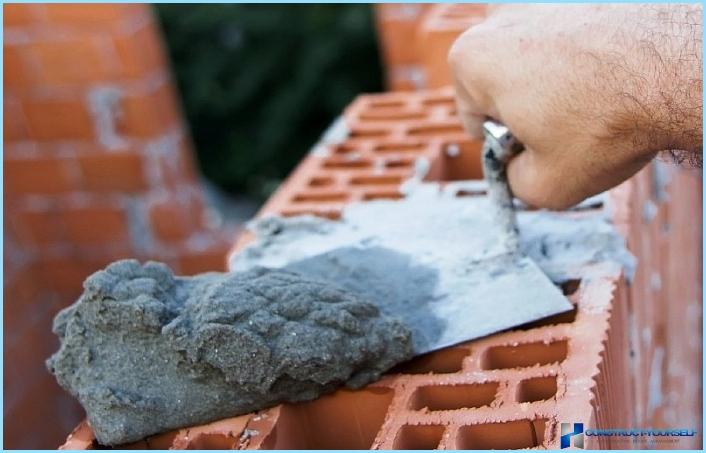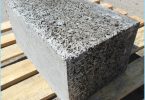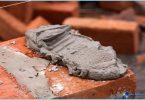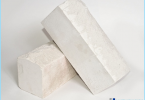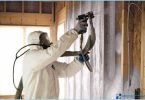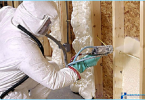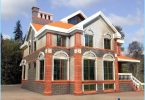The contents
Brick is one of the most popular materials for the construction of buildings, which is popular now and was so many years ago. He is known for his positive qualities, strength and durability. Meanwhile, no one component for masonry walls, the entire structure will be useless. What are you talking about? About the mortar for the bricks.
Everyone knows that just stacked on top of other bricks without it would not stick. One more push and the whole structure will fall. To make the construction durable and long lasting, it is important to use quality mortar between the bricks. What you need to know about ready mix? How to prepare a solution with your hands? What’s in it? How much of the mixture in a cube of masonry? How thick is the seam? About all it we will talk further.
Ready mix what they are ↑
The main components for masonry walls are cement, sand and water. This is a standard set. But, depending on the type of work, the components of the mortar of the brick walls can change. For example, the composition of the added lime, clay and gypsum. Depending on the components, there are several types:
- cement-sand;
- cement-limestone;
- cement-clay.
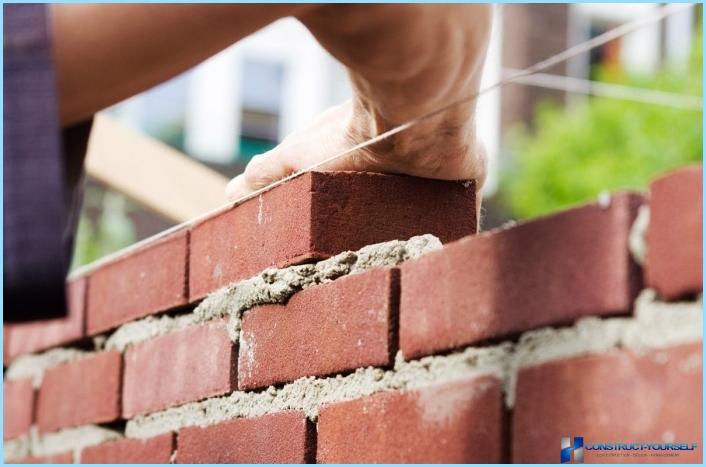
The name itself suggests what components are included in their composition, and the difference between them.
Cement-sand ↑
A mixture of cement and sand is more durable and resistant to water. But, she’s tough and is not plasticity. It is used for the external masonry walls. Depending on how much of one or the other component is, in part, distinguish the brand of solution. To prepare the mixture with your hands, use the table below.
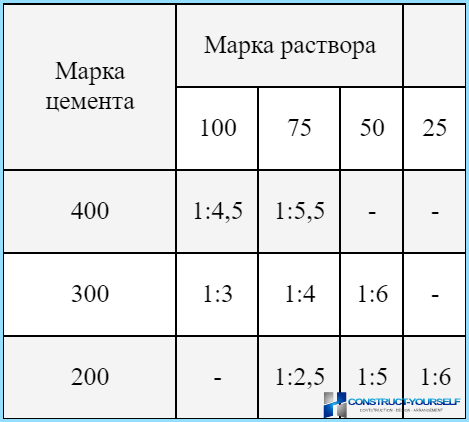
How to cook with your own hands? In a container pour the sand and cement in required proportion. Mix thoroughly all. Then gradually add water. How much? Until the mixture acquires the desired consistency. It should be as sour cream.
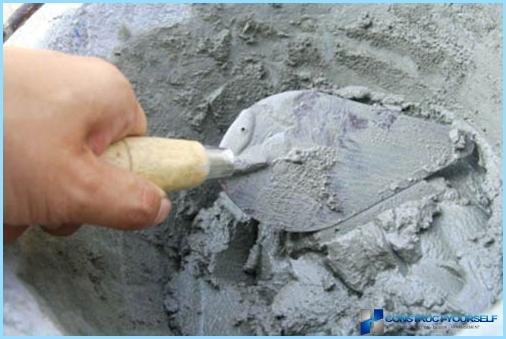
That’s all. This is the easiest to prepare solution.
Cement-limestone ↑
It turns out «warm» and plastic. It is made from cement, sand and limestone test. Lime needs to be repaid. Unlike cement-sandy solution, it is not so durable and is used for masonry walls inside the building, where water and external factors will not affect him.
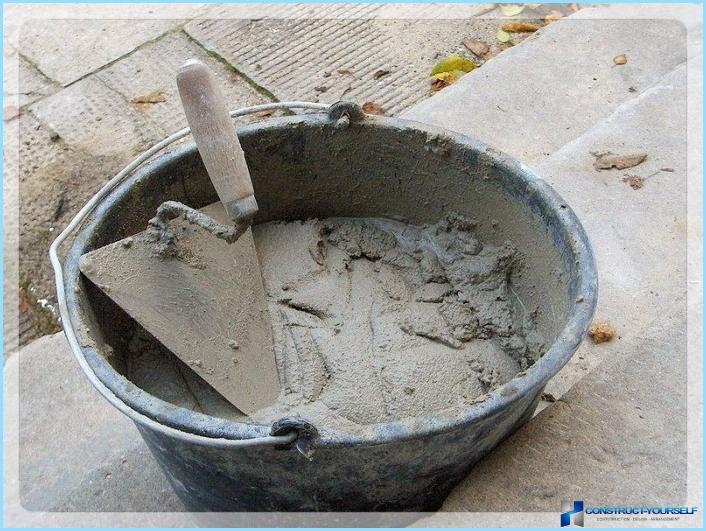
To prepare the mortar for masonry with their hands, look at the proportions (cement:lime:sand).
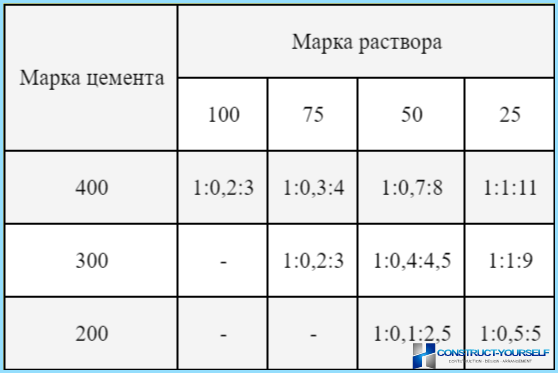
How to cook with your own hands? Limestone, spread the dough so that the thickness of it was like milk. Strain the milk through a clean sieve to the dirt not affect the finished mixture. Meanwhile, take the sand and cement and prepare the dry mixture. Then pour all limestone milk and mix thoroughly.
Cement-clay ↑
A medium strength solution. Is quick to grasp. One of the advantages is that the mixture of clay can be used even in winter. This is due to the properties of clay – it holds moisture.
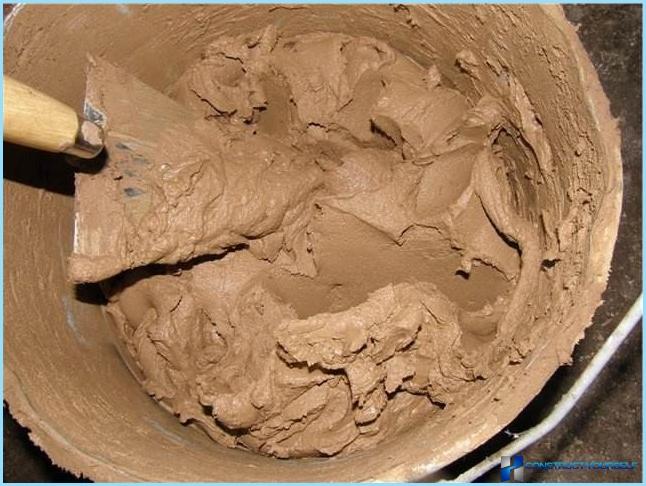
In the end, in the spring when everything thawed, the strength becomes higher. Below is a table that indicate the brand and the proportions of the cooking with your hands (cement:clay:sand).
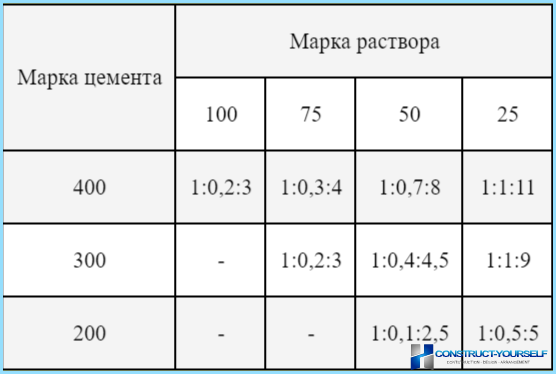
How to cook with your own hands? The first thing you need to cook clay dough. To soften the clay, moisten it with water. Take a container, pour the clay with water and mix. Water is needed so that the mass resembled a sour cream consistency. Mix thoroughly and let stand for to clay a few days. Then drain the mixture through a sieve, the cells of which no less than 3?3 mm, in another container. Mix the sand and cement and then add the clay, thoroughly stirring.
Coverage ↑
To say immediately how much of the solution in the cube of masonry impossible. Common standards is not, as it is affected by many factors:
- The thickness of the seam between the bricks. Everything is simple and clear, the bigger it is between them, the greater the flow rate, and Vice versa. Most often, the thickness of the finished mortar between the bricks is 12 mm. But even if you reduce or increase it by 2 mm, the flow rate of the mixture solidly in the cube to increase or decrease.
- The thickness of the walls (half-brick, one and a half, two, two and a half). Depending on what it is, consumption changes. For example, if we take the standard brick size 250?120?65, that in a cube of masonry consumption of the following: a half-brick (12 cm wall thickness) – 0,189 mThree, one brick (25 cm wall thickness) – 0,221 mThree, and a half (38 cm) – 0,234 mThree, two (51 cm) – 0,240 mThree, two and a half (64 cm thickness) -0,245 mThree solution.
- The important role played by the brick. What it is, the less the expense. The same applies to its structure. If it is hollow, the solution will penetrate into the pores between the bricks and therefore need more.
It is important to consider all of these points, to correctly calculate the amount of solution in a cube of masonry.
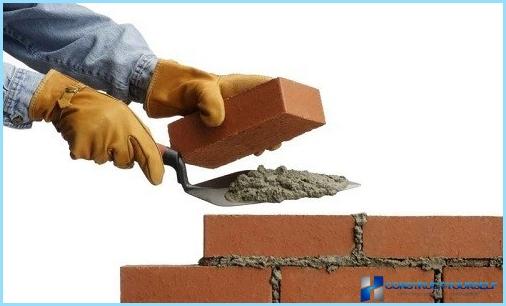
Do not forget about the solidification rate of the finished mixture. If you do it too much and you don’t use, it just get dry and lose their properties. When the team works, for kneading you can use the mixer. In the case when the work is done only with your hands, is enough to prepare a bucket or small container.
How to calculate cement consumption per cubic meter ↑
As you understand, prepare and purchase supplies is very important. You should know in advance how much you will need building materials, to their left, as this extra cost. And it requires not only calculate how many bricks in a cube of masonry with mortar, but also to consider sand and cement. How to do it? Let’s consider the example.

You build a house, the long walls 15 m, with a height of 3.40 m. It has 7 Windows, with dimensions of 1.80?1.20 m each. In the outer walls there are 2 doorways, the size of which of 2.10?1.30 m. the Total length of the walls inside – 42 m, despite the fact that they have 5 doors, the size of 2.0?1.30 m each. The outer walls have a thickness of 2.5 bricks, which is equal to 64 see the Internal walls are 25 cm (1 brick). Now you want to calculate the total volume of brick masonry for the walls outside and inside.
Exterior walls: 4?15?3,4 = 204 mThree. From this amount, subtract the window openings: 7?1,8?1,2 = 15,12 mThree. And door openings: 2?2,1?1,3 = 5,46 mThree. Total it turns out: 204 – 15,12 – 5,46 = 183,42 mThree. Multiply the volume by the thickness of the walls: 183,42?0,64 = 117,39 mThree.

Interior walls:42?3,4 =of 142.8 mThree. Deducted doorways: 5?2?1,3 = 13 mThree. The total volume of the inner walls: (142,8 – 13) ?0,25 = 32,45 mThree. Now summarize the total volume of the walls outside and inside: 117,39 + 32,45 = 149,84 mThree.
You can now easily find out how many components need. As 25% of the total volume is the solution, the calculations are the following: 149,84?0,25 = 37,46 mThree ready mix. If the ratio of cement and sand is selected 1:4, then subtract the expense just: 37,46/4 = 9,365 mThree dry cement. How much is in the bags? The average density of 1300 kg cement/mThree. Means: 9,365?1300 = 12174,5 kg. If you take the bags of 50 kg, then: 12174,5/50 = 244. But it is better to take with a reserve just in case by increasing figure of 5-7%. Total – for the solution you need 256 bag of cement.
Sand for cement mortar ↑
Also important is the sand used for mortar for laying bricks. It must meet requirements and be of high quality. The first thing it needs to be sifted, removing all impurities and organic particles. To easily do this with your hands, you can use more mesh or metal mesh.
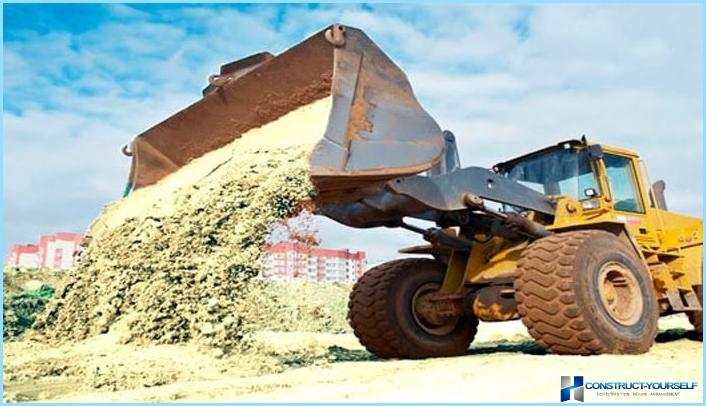
Meanwhile, to give preference to better river sand, average grain size, not more than 2.5 mm. It needs to be unwashed as washed will be «to sit». Washed is used only in the case when the veneer is placed. To the laying of the brick was perfect, use unwashed river sand, medium grit, pre-sifted and cleaned of impurities. It will make the solution is suitable to use a mixture on purpose.
To summarize ↑
To make a good mortar for masonry with their hands easily if you strictly follow the instructions. Stick to the right ratio, buy quality components and calculate in advance the number of materials. Then your building will be durable, reliable and will last many years.

